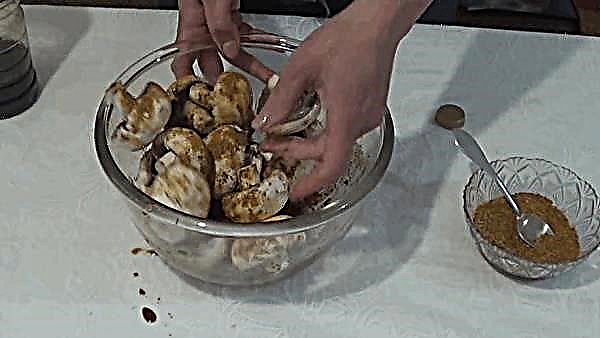A cow is an important animal in the farm. Being a sacred animal in some cultures, cows are actively used in others mainly for milk and meat. In this regard, the breeder must know not only how to take care of the cow on the farm, but also how to behave if the animal becomes ill. One of the most common and dangerous diseases is cow pox.
What is this disease
Cowpox is an infectious disease characterized by a weakening of the animal, a significant increase in body temperature and the appearance of ulcers and growths on the udder. Smallpox in cows can be caused by two strains: genuin, or pure virus (Cow orthopoxvirus), and vaccine (Vaccina orthopoxvirus). Infection with the first strain is extremely rare today, while the second infection occurs mainly during vaccination of farm personnel and is transmitted to cows in the following ways:
Smallpox in cows can be caused by two strains: genuin, or pure virus (Cow orthopoxvirus), and vaccine (Vaccina orthopoxvirus). Infection with the first strain is extremely rare today, while the second infection occurs mainly during vaccination of farm personnel and is transmitted to cows in the following ways:
- contact (when a milkmaid touches an animal through a peeling epithelium);
- airborne (through discharge from the oral and nasal areas);
- transmissible (bites of rodents and insects);
- alimentary (through feces).
Important! In addition to the udder, ulcers and growths can also cover the hips, back, head and neck.
The lack of vitamins in the body can also be a factor contributing to the infection and the development of the disease, especially in the winter. The disease is characterized by extreme contagion - one sick animal can infect the entire livestock. Infection can also occur after the interaction of cows with food, water or instruments infected with smallpox spores.
Causes of cattle
There may be several reasons for the occurrence of smallpox, and all of them are directly related to the conditions of the cows:
- lack of vitamins due to poor quality and / or malnutrition;
- poorly ventilated barn;
- lack of regular airing;
- dirt in the stall, hay not changing for a long time;
- high humidity in the stall;
- non-compliance with the temperature regime.
Important! One way to reduce the chance of infection during the vaccination period is to follow personal hygiene rules.
Symptoms and course of the disease
Smallpox develops quickly enough, and the following symptoms are inherent in it:
- a significant increase in animal body temperature (up to 40–41 degrees Celsius);
- general weakness, loss of appetite;
- decrease in milk yield;
- unwillingness of a cow to allow a person to milk;
- the appearance on the udder of papules, which over time grow into abscesses and cracks;
- "Wide stance" - the animal is trying to maximize the hind limbs.
 The incubation period of cowpox ranges from three days to two weeks. After this period, a rash (pustules) appears on the udder. Outwardly, they look like tubercles with clearly visible internal bruising and depressions. Seven to ten days later, the pustules mature and burst, merging into one brown spot. In parallel with external manifestations, internal hemorrhages occur in the body.
The incubation period of cowpox ranges from three days to two weeks. After this period, a rash (pustules) appears on the udder. Outwardly, they look like tubercles with clearly visible internal bruising and depressions. Seven to ten days later, the pustules mature and burst, merging into one brown spot. In parallel with external manifestations, internal hemorrhages occur in the body.The animal is weakening more and more, refusing to eat and milking, trying to position its hind legs as widely as possible. An increase in temperature causes fever. Complications in the form of tremor and damage to the respiratory system are possible.
Did you know? A person can also get smallpox from cows, but after the first case of infection, the body develops immunity.
Diagnostics
Visual inspection plays an important role in the diagnosis of this disease. However, some external manifestations of the disease, in particular a rash, may be a symptom of other ailments. In this regard, to diagnose the disease in an animal, a liquid sample is taken from the rash for laboratory tests - staining, biological testing on chicken embryos and rabbits. An equally important role in diagnosing the disease is played by the autopsy of recently dead cattle. In any case, you should contact your veterinarian.
In this regard, to diagnose the disease in an animal, a liquid sample is taken from the rash for laboratory tests - staining, biological testing on chicken embryos and rabbits. An equally important role in diagnosing the disease is played by the autopsy of recently dead cattle. In any case, you should contact your veterinarian.
Important! If the disease manifests itself in a newly acquired animal, it is necessary to obtain information from the seller regarding cases of smallpox at the previous location of the cow.
Pathological changes
The main pathological change during the disease is the appearance of a rash that gradually forms large brown spots on the udder. As the disease develops, the spots dry out, and a crust forms in their place, which can crack, thereby giving the cow additional discomfort and pain. Internal manifestations are characterized by hemorrhages in the body and abscesses. The disease can also cause complications in the form of ulcers and mastitis, which greatly complicate milking. When infected with a strain of genoa pox, the tissues are damaged much deeper, and therefore the rash does not look like tubercles, but like small dark spots.
Internal manifestations are characterized by hemorrhages in the body and abscesses. The disease can also cause complications in the form of ulcers and mastitis, which greatly complicate milking. When infected with a strain of genoa pox, the tissues are damaged much deeper, and therefore the rash does not look like tubercles, but like small dark spots.
How and how to treat
After the cow has been diagnosed with smallpox, treatment can begin.
General recommendations
The treatment itself should be carried out under the supervision of a veterinarian, since the doctor will be able to choose the most suitable medications, as well as monitor the treatment process and adjust it if necessary. Nevertheless, it is worthwhile to carry out a number of activities that will contribute to the treatment:
- isolation of a sick animal so that it does not infect the rest of the livestock;
- disinfection in the barn and its regular ventilation;
- transfer to feeding liquid mixtures and the exclusion of low-quality food;
- maintaining dryness to avoid suppuration;
- daily milking of the cow to prevent mastitis (special catheters are recommended).

Drug treatment
The basis for the treatment of smallpox is medications, both external and intravenous (mainly antibiotics). These include:
- antiviral ointments 2-3 times a day - Florenal (0.5%), Oxolinic (3%), Ectaridine lactate (3%), Tebrofenova (5%) for fourteen days;
- 2 times a day - Metisazon (0.6 g) five to six days;
- 2 times a day - anti-venom immunoglobulin (0.3–0.6 g) for five to six days.
Important! When choosing medications, be sure to consult a doctor.
Can I drink milk from sick animals
Opinions regarding whether milk from cows with smallpox can be eaten differ. Some farmers believe that milk can be disinfected by boiling or pasteurization and then suitable for drinking, while others argue that milk from sick animals should be disposed of. The second option is preferable, since any potential harm to health should be excluded.
Smallpox vaccine
Smallpox vaccinations for cows come in two forms - separately for each strain. However, the effect of vaccinations varies: vaccination against a smallpox strain is performed once and provides lifelong immunity, while vaccination against a mixed smallpox strain gives immunity for only a few months, after which repeated vaccination is necessary.
Did you know? Smallpox vaccine was invented by chance. In 1796, a young doctor Edward Jenner, while on a farm, noticed that milkmaids who were in contact with smallpox cows developed a milkmaid immunity to the disease. The doctor conducted an experiment by introducing a strain of virus from a sick animal to a person, and thus opened the vaccine.
Other preventive measures
In addition to vaccinating livestock, disease prevention can be carried out in other ways:
- monitoring of nearby agriculture for smallpox;
- control the cleanliness of food, water and equipment;
- keeping newly acquired animals separately from the rest of the herd for the first month and a half;
- treatment of the udder with antiseptics;
- compliance with personal hygiene;
- regular vaccination of personnel against smallpox, after which the vaccinated are not allowed to livestock for fourteen days;
- isolation of a sick animal from the rest of the herd to prevent further spread of infection;
- utilization of milk received from sick cows.
 Smallpox is a common and dangerous disease if left untreated. The best way to deal with it is to keep the stall clean, monitor animals and personnel for infection, and consult a veterinarian if the animal is sick.
Smallpox is a common and dangerous disease if left untreated. The best way to deal with it is to keep the stall clean, monitor animals and personnel for infection, and consult a veterinarian if the animal is sick.












